Abstract
Resistance to the feeding activities of ixodid ticks has previously been shown to be an acquired, immunologically-mediated phenomenon in guinea-pigs, associated with cutaneous hypersensitivity to tick antigens. Also, there is circumstantial evidence to support the suggestion that epidermal Langerhans cells may play roles in the acquisition and expression of tick resistance. In this in vitro study, lymphocyte blastogenesis assays were performed using column-purified lymph node cells from naive or tick-sensitized guinea-pigs as responder cells. Syngeneic macrophages or epidermal Langerhans cells, incubated with tick salivary antigens, were used as stimulator cells. Epidermal cell populations, containing viable Langerhans cells, were prepared by two different protocols. Epidermal cell populations containing ATPase-positive, Fc receptor- and Ia-bearing cells (Langerhans cells), when incubated with tick antigen, produced detectable proliferative responses in responder cells from tick-sensitized guinea-pigs. Antigen-incubated, Ia-bearing macrophages produced similar responses. It is concluded that, as has been shown in man and the guinea-pig with other antigens, Langerhans cells, like Ia-bearing macrophages, can act as antigen-presenting accessory cells in the immunological responses of guinea-pigs to tick infestations.
Full text
PDF
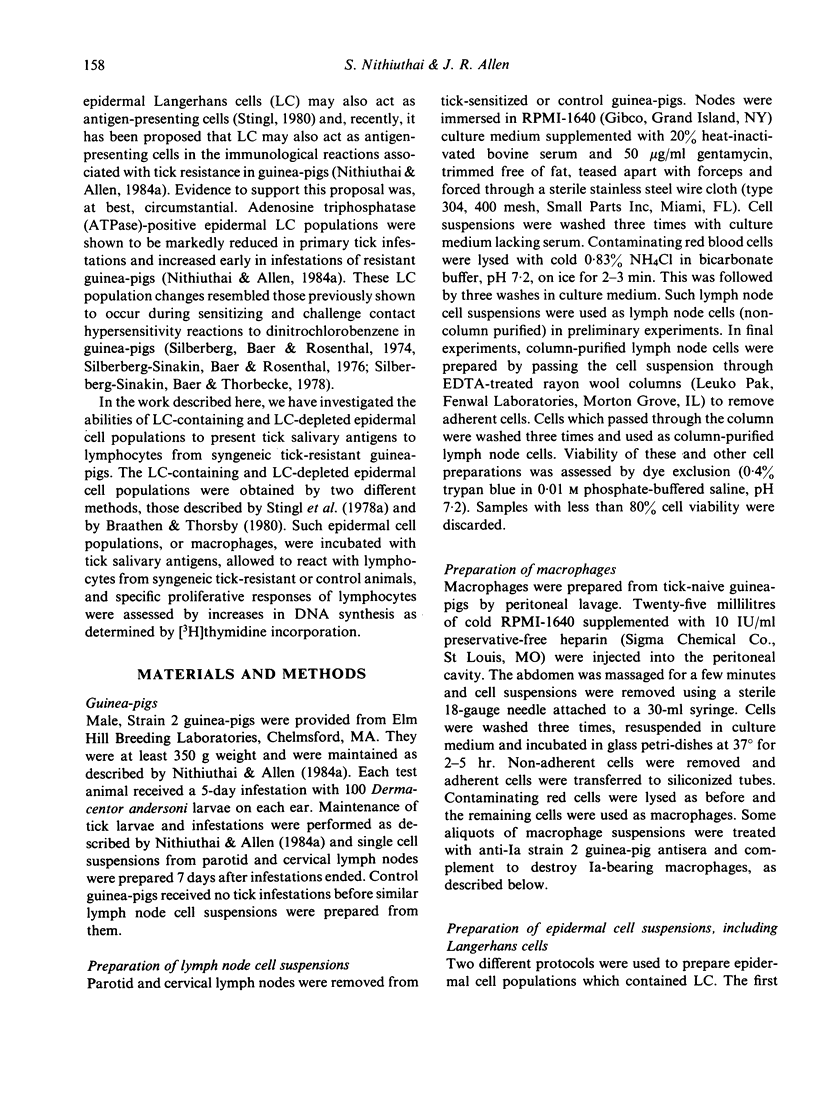
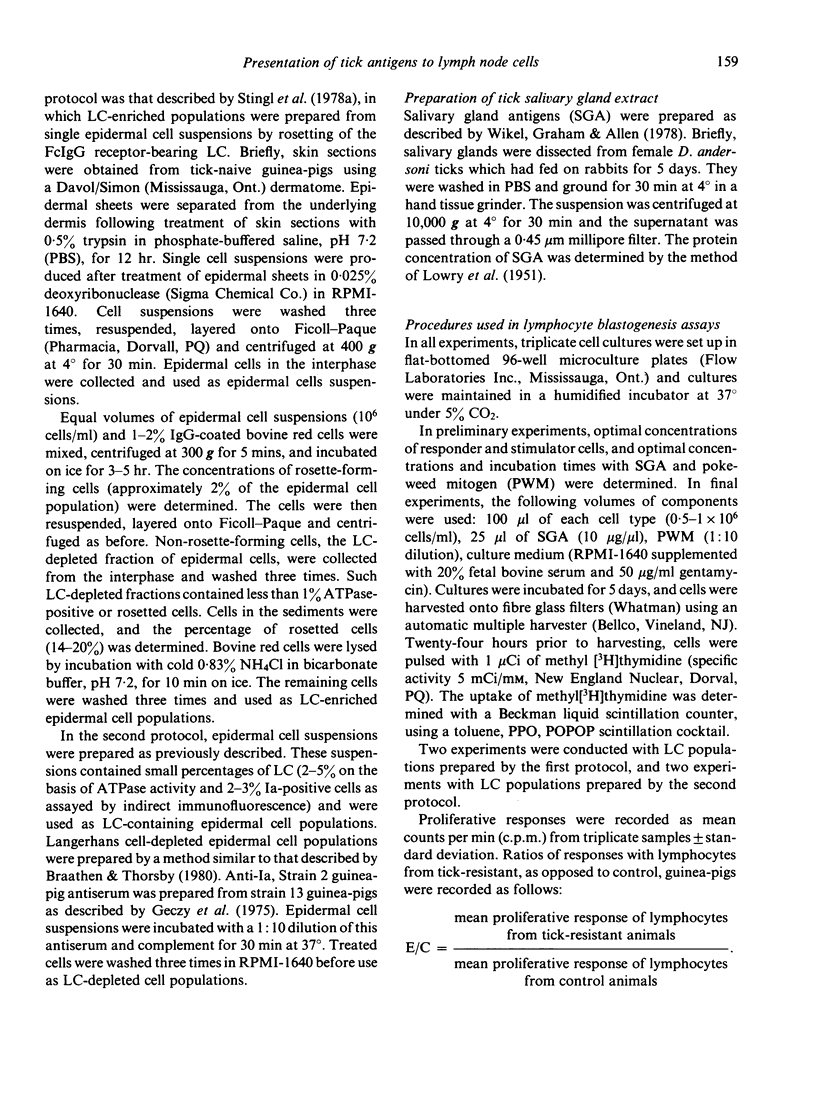
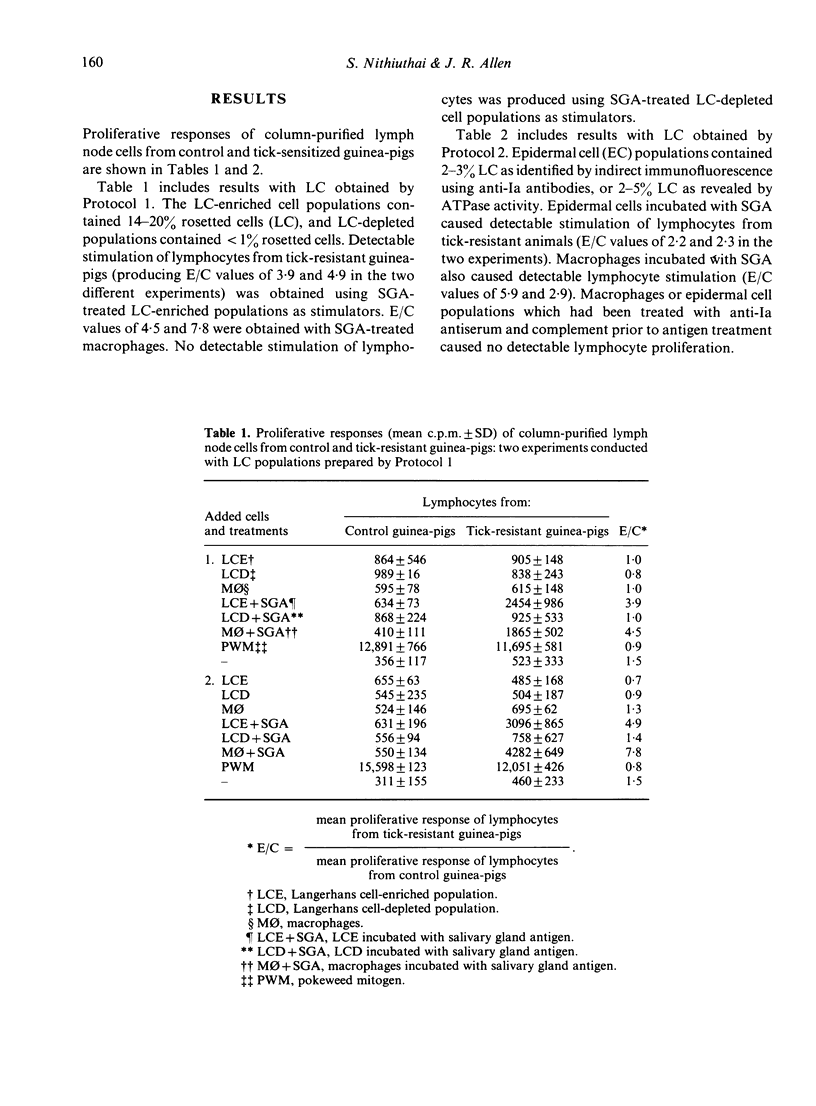
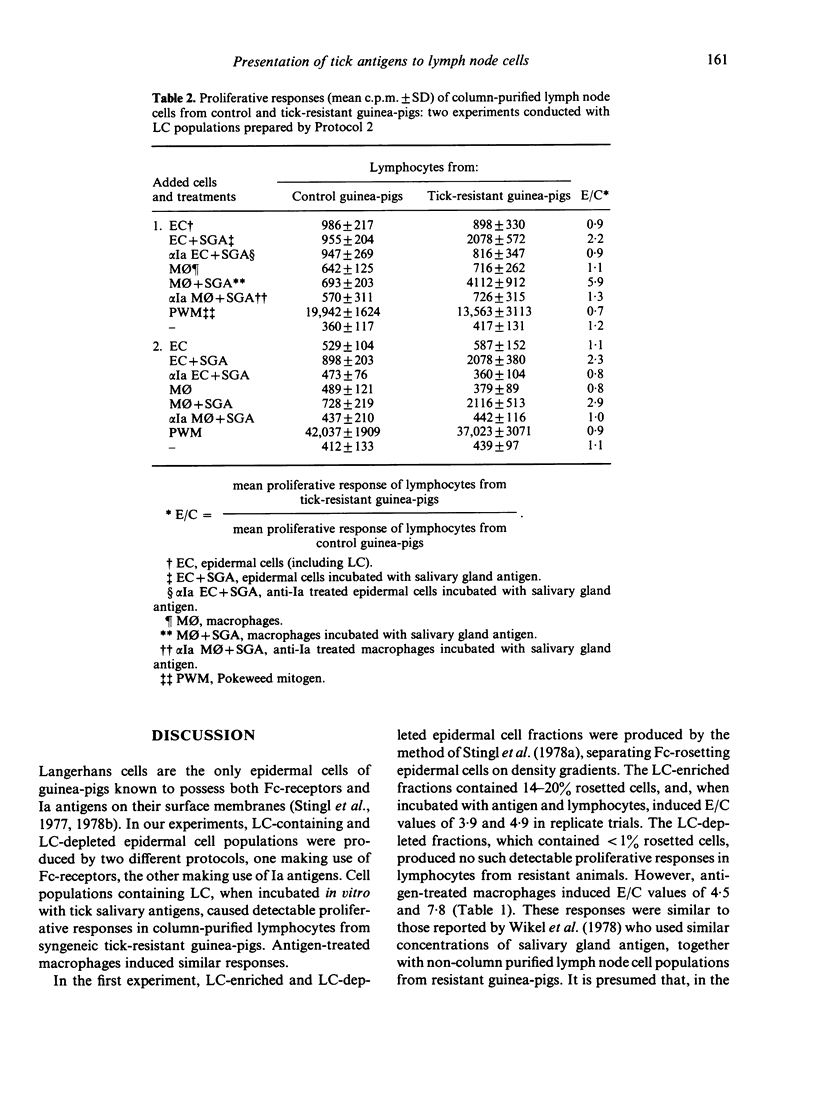
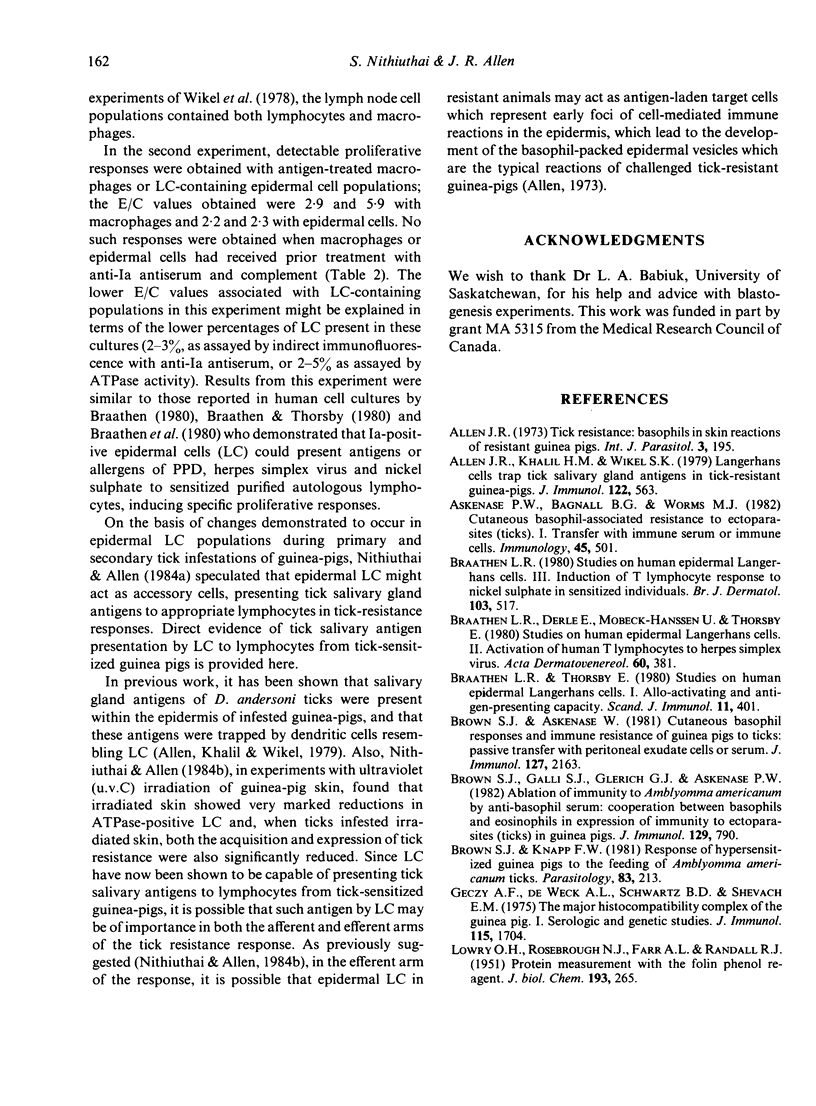
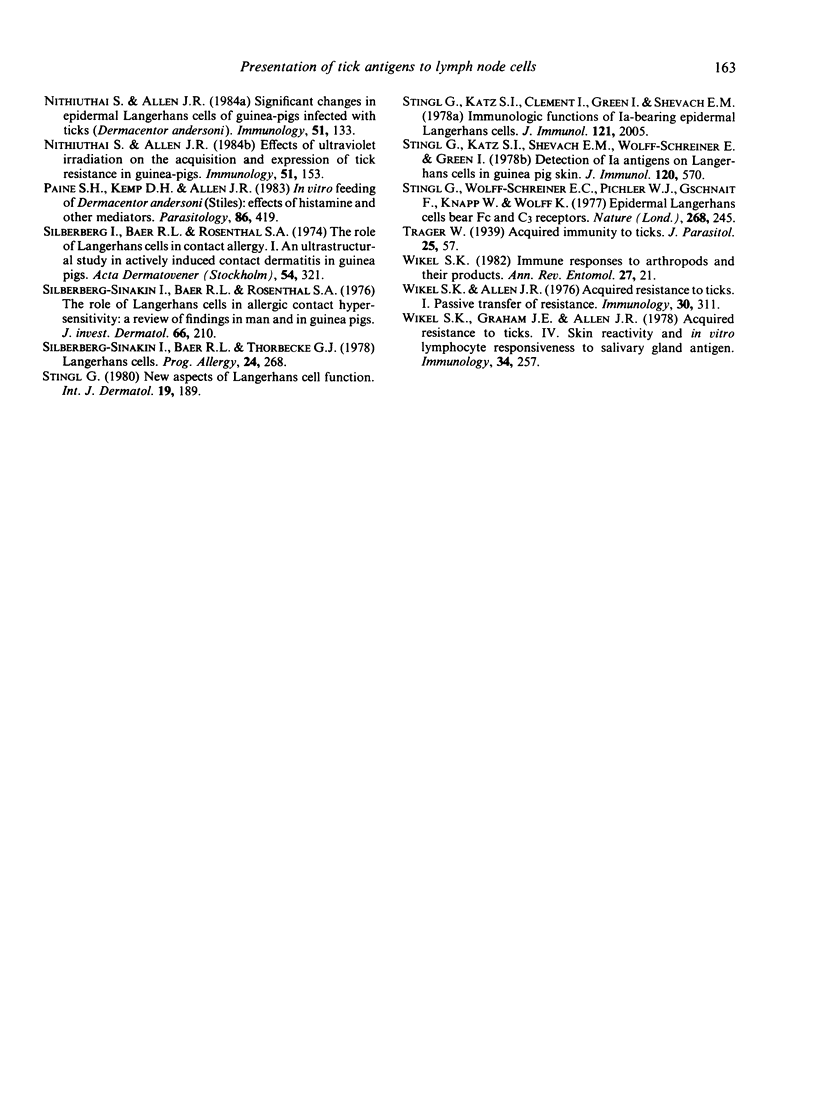
Selected References
These references are in PubMed. This may not be the complete list of references from this article.
- Allen J. R., Khalil H. M., Wikel S. K. Langerhans cells trap tick salivary gland antigens in tick-resistant guinea pigs. J Immunol. 1979 Feb;122(2):563–565. [PubMed] [Google Scholar]
- Allen J. R. Tick resistance: basophils in skin reactions of resistant guinea pigs. Int J Parasitol. 1973 Mar;3(2):195–200. doi: 10.1016/0020-7519(73)90024-6. [DOI] [PubMed] [Google Scholar]
- Askenase P. W., Bagnall B. G., Worms M. J. Cutaneous basophil-associated resistance to ectoparasites (ticks). I. Transfer with immune serum or immune cells. Immunology. 1982 Mar;45(3):501–511. [PMC free article] [PubMed] [Google Scholar]
- Braathen L. R., Berle E., Mobech-Hanssen U., Thorsby E. Studies on human epidermal Langerhans' cells: II. Activation of human T lymphocytes to herpes simplex virus. Acta Derm Venereol. 1980;60(5):381–387. [PubMed] [Google Scholar]
- Braathen L. R. Studies on human epidermal Langerhans cells III. Induction of T lymphocyte response to nickel sulphate in sensitized individuals. Br J Dermatol. 1980 Nov;103(5):517–526. doi: 10.1111/j.1365-2133.1980.tb01666.x. [DOI] [PubMed] [Google Scholar]
- Braathen L. R., Thorsby E. Studies on human epidermal Langerhans cells. I. Allo-activating and antigen-presenting capacity. Scand J Immunol. 1980;11(4):401–408. doi: 10.1111/j.1365-3083.1980.tb00006.x. [DOI] [PubMed] [Google Scholar]
- Brown S. J., Askenase P. W. Cutaneous basophil responses and immune resistance of guinea pigs to ticks: passive transfer with peritoneal exudate cells or serum. J Immunol. 1981 Nov;127(5):2163–2167. [PubMed] [Google Scholar]
- Brown S. J., Galli S. J., Gleich G. J., Askenase P. W. Ablation of immunity to Amblyomma americanum by anti-basophil serum: cooperation between basophils and eosinophils in expression of immunity to ectoparasites (ticks) in guinea pigs. J Immunol. 1982 Aug;129(2):790–796. [PubMed] [Google Scholar]
- Brown S. J., Knapp F. W. Response of hypersensitized guinea pigs to the feeding of Amblyomma americanum ticks. Parasitology. 1981 Aug;83(Pt 1):213–223. doi: 10.1017/s0031182000050174. [DOI] [PubMed] [Google Scholar]
- Geczy A. F., de Weck A. L., Schwartz B. D., Shevach E. M. The major histocompatibility complex of the guinea pig. I. Serologic and genetic studies. J Immunol. 1975 Dec;115(6):1704–1710. [PubMed] [Google Scholar]
- LOWRY O. H., ROSEBROUGH N. J., FARR A. L., RANDALL R. J. Protein measurement with the Folin phenol reagent. J Biol Chem. 1951 Nov;193(1):265–275. [PubMed] [Google Scholar]
- Nithiuthai S., Allen J. R. Effects of ultraviolet irradiation on the acquisition and expression of tick resistance in guinea-pigs. Immunology. 1984 Jan;51(1):153–159. [PMC free article] [PubMed] [Google Scholar]
- Nithiuthai S., Allen J. R. Significant changes in epidermal Langerhans cells of guinea-pigs infested with ticks (Dermacentor andersoni). Immunology. 1984 Jan;51(1):133–141. [PMC free article] [PubMed] [Google Scholar]
- Paine S. H., Kemp D. H., Allen J. R. In vitro feeding of Dermacentor andersoni (Stiles): effects of histamine and other mediators. Parasitology. 1983 Jun;86(Pt 3):419–428. doi: 10.1017/s0031182000050617. [DOI] [PubMed] [Google Scholar]
- Silberberg-Sinakin I., Baer R. L., Thorbecke G. J. Langerhans cells: a review of their nature with emphasis on their immunologic functions. Prog Allergy. 1978;24:268–294. [PubMed] [Google Scholar]
- Silberberg I., Baer R. L., Rosenthal S. A. The role of Langerhans cells in allergic contact hypersensitivity. A review of findings in man and guinea pigs. J Invest Dermatol. 1976 Apr;66(4):210–217. doi: 10.1111/1523-1747.ep12482139. [DOI] [PubMed] [Google Scholar]
- Silberberg I., Baer R. L., Rosenthal S. A. The role of langerhans cells in contact allergy. I. An ultrastructural study in actively induced contact dermatitis in guinea pigs. Acta Derm Venereol. 1974;54(5):321–331. [PubMed] [Google Scholar]
- Stingl G., Katz S. I., Clement L., Green I., Shevach E. M. Immunologic functions of Ia-bearing epidermal Langerhans cells. J Immunol. 1978 Nov;121(5):2005–2013. [PubMed] [Google Scholar]
- Stingl G., Katz S. I., Shevach E. M., Wolff-Schreiner E., Green I. Detection of Ia antigens on Langerhans cells in guinea pig skin. J Immunol. 1978 Feb;120(2):570–578. [PubMed] [Google Scholar]
- Stingl G. New aspects of Langerhans' cell function. Int J Dermatol. 1980 May;19(4):189–213. doi: 10.1111/j.1365-4362.1980.tb00297.x. [DOI] [PubMed] [Google Scholar]
- Stingl G., Wolff-Schreiner E. C., Pichler W. J., Gschnait F., Knapp W., Wolff K. Epidermal Langerhans cells bear Fc and C3 receptors. Nature. 1977 Jul 21;268(5617):245–246. doi: 10.1038/268245a0. [DOI] [PubMed] [Google Scholar]
- Wikel S. K., Allen J. R. Acquired resistance to ticks. I. Passive transfer of resistance. Immunology. 1976 Mar;30(3):311–316. [PMC free article] [PubMed] [Google Scholar]
- Wikel S. K., Graham J. E., Allen J. R. Acquired resistance to ticks. IV. Skin reactivity and in vitro lymphocyte responsiveness to salivary gland antigen. Immunology. 1978 Feb;34(2):257–263. [PMC free article] [PubMed] [Google Scholar]
- Wikel S. K. Immune responses to arthropods and their products. Annu Rev Entomol. 1982;27:21–48. doi: 10.1146/annurev.en.27.010182.000321. [DOI] [PubMed] [Google Scholar]


